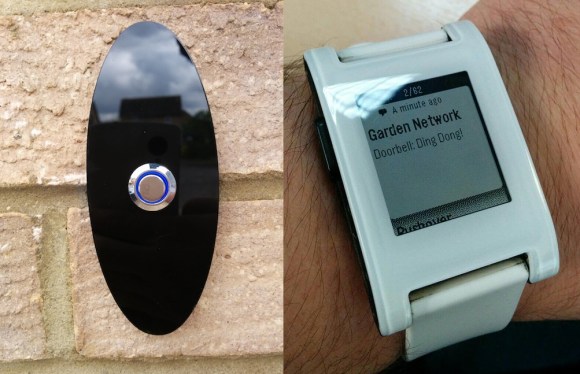
A Pebble smart watch, and a Raspberry Pi. They are a perfect match. This is probably what [Daniel] thought when he embarked upon his latest project, a smart doorbell called the PebblyPi (tip submitted by [Ben]).
The actual project is quite easy to implement. All you need really need is a Raspberry Pi, a switch, a resistor, and a Pebble Smart Watch (plus a smart phone). Using a simple Python script on the Raspberry Pi, button press notifications are sent to Pushover, which allows the notification to arrive on your smart phone (and thus your Pebble Smart Watch). Pushover is a very cool notification service for Android devices, iPhones, iPads, and your Desktop. The concept behind this project is great, and the fact that it is so simple to implement opens up many other possibilities for interfacing your home electronics with the Pebble Smart Watch (or even just your smart phone). The ability to create custom notifications on any of your devices using any internet connected system is amazing!
You could receive notifications from your absurdly accurate weather station, or even your soil moisture monitor. Have you used Pushover in any of your projects? The possibilities are endless!
















If you have a Ninja Block (or a Raspberry Pi with their “Pi Crust” 433mhz addon), then you can do stuff like this with an off-the-shelf doorbell and their recently-released Pushover / Pushbullet driver. Open up the NB website, click on Rules and make a new rule that says if doorbell = pressed, send message to Pushover / Pushbullet.
The driver doesn’t work on my system (a bug with the RPi, I think) but the doorbell does, so I can get an email instead. Too easy!
Hi Ben who tipped you off here.
I am glad you picked it up. What I loved about his project was the simplicity of each step coming together to make something that works well using some fairly common equipment if you are into hacking. Including the use of a hackspace’s laser cutter to give the button its surround, that was the icing on the cake.
It has given me a kick up the backside to finish some of my projects.
Feel free to update the tip submitted by to include my surname ;)
Cheers,
Ben Sycha
I was able to do something similar, by sending an email upon detection of the doorbell button. The biggest issue I have is that the email round trip can sometimes be excessive. Latency of just 20 to 30 seconds means the guest at the door has given up and left by the time I get the message on my phone.
But perhaps Pushover is (consistently) faster. I’ll give it a try. Thanks for the tip!
I used to use Pushover and it was pretty darn fast, but I don’t remember exact times. I use Pushbullet now and generally see pushes go from Desktop to phone in 1 – 3 seconds.
Sounds about right to me.
The PebblyPi takes anywhere between 1 and 5 seconds to complete a notification to the pebble. The other latency is the notification from phone to pebble, which is usually around 1 second.
Come on dawgs, putting one button at a raspberry pi and runing just a python script on it seems quite wasting the potential of those boards
Also scattering arround these boards everywere will guarantee you an nice
electricity bill backpay, as these 5V switchmode bricks are everythung but efficient…
Do you have a solution for this? I like tinker arduino-projects, but I cant sleep at night when I think about those low-efficient 5V USB Charger plugged into my Main-Outlet and crunching 240V->5V all the time.
I put two high efficiency switchmode supplys under my desk (one for 12v and one 5V)
and throw speaker cables behind my carpet base boards in every room where I need such supply (easily extendable)
so everywhere i need some low voltage juice I just have to put a branch box with some usb and lab sockets
Voltage drop?
There was a proposal years ago to run 12v around houses along with mains to eliminate all of those transformers.
These days it’s power points with USB sockets instead. Still doesn’t solve the problem of have dozen of little power supplies running 24/7.
Better to do it the present way than run a low-voltage bus round the house, just cos of what you said, voltage drop. Same reason they distribute the mains at however-many hundred kilovolts around a country. The extra PSUs beat having voltage drop and thick wires everywhere. Especially if it’s dropped below useful by the time it gets there.
Might be running a low-voltage supply round your house is more wasteful than just converting it where it’s needed.
Post Author here :-)
I agree its a bit simple by hackaday standards but it is the first step in a much larger project (hackaday project site pending).
Also sometimes it is worth highlighting the starting points for all the beginners out there. After all, everyone begins somewhere and if this post helps someone get into electronics, software, or technology in general it is worth it.
Daniel
Nice one Danny!
Could see this as a massive potential for care homes where you may need sudden call up in case of emergencies.
Looks like a nice gadget but I prefer my MP3 doorbell from usbdoorbell.com. It is awesome and sounds great. I can truly recommend it.